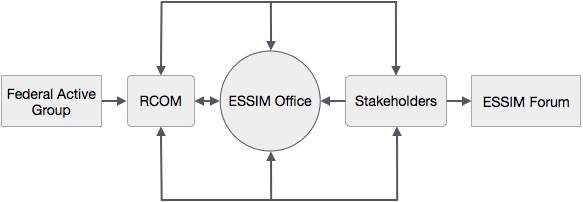
- Collaborative Management Home
- Introduction
- Collaboration System
- Leadership Styles
- Collaborative Approach
- Collaborative Tools
- The Arc's Model
- The ESSIM Initiative
- Collaborative System
- Change Management
- Collaborative Project Management
- Project Management Architecture
- Application & Implementations
- Conflict Management
- Case Study
The ESSIM Initiative
The ESSIM Forum is a collection of all organizations, groups, and individuals having an interest in the ESSIM Initiative.
Principles
The proposed principles that provide the foundation for the ESSIM Collaborative Planning Model include the following −
Jurisdiction
The ESSIM initiative seeks to create an integrated framework by including all mandates and departments, agencies, and groups within the planning process.
The plan should be consistent with the interests of responsible authorities.
Government sector meetings take place within a two-part structure. The Regional Committee on Ocean Management (RCOM) and the Federal-Provincial ESSIM Working Group has the ability to work horizontally.
Inclusion
The ESSIM Initiative is as open as possible at all levels, given the limitations of the ESSIM Forum and the Stakeholder Roundtable.
Complete, active, and effective participation of all sectors and interests is essential.
Consensus
Consensus is achieved and maintained through stakeholder collaboration, which is the fundamental principle of the ESSIM Initiative.
Participants work towards consensus in good faith. The process is designed in such a way that lack of consensus cannot be used as a tactic for delay.
In the absence of consensus, the practices of respective government departmental mandates are used in decision-making processes.
Accountability
ESSIM members are accountable to their constituents for specific results and to each other for defining and achieving collective goals. Members are also accountable to each other to ensure that their input is fully informed and reflective of constituents views and interests.
Dispute Resolution
For effective dispute resolution, it is better to have a multi-level system that can be used as required to assist parties to discuss differences in understandings, perspectives, styles, interests, values, and institutional structures and processes.
Network
An efficient network provides opportunities for dialogue and consensus at several levels and among various configurations of participants. It also confirms the authority and responsibility of existing organizational mandates.
Learn by Doing
After years of preparation, presently ESSIM has several working groups developing ecosystem and human use objectives for a pilot area. ESSIM formally adopts an adaptive approach that allows it to plan, act, learn, adapt, and move forward through the use of a structured, disciplined approach to dialogue, as well as using the best available science.
Collaborative Planning Model
This section includes ESSIM Forum, Stakeholder Roundtable, and the Planning Office.
The ESSIM Forum
It is a collection of all organizations, groups, and individuals who are Stakeholders i.e., they may be influenced by, have the ability to influence, or have an interest in the ESSIM Initiative.
ESSIM Stakeholder Roundtable
The Roundtable is a broad representation of ESSIM sectors and stakeholders. It is not entertained that its size would increase beyond 26 (+ 2) members without taking some steps to aggregate interests or uses some other means to enable participation while maintaining a reasonable working size limit.
ESSIM Planning Office
The planning office includes expertise plan development procedures. It provides coordination and support for the ESSIM Forum and the Stakeholder Roundtable. It provides resources for conflict resolution when required, liaise with other regional, national and international processes, and provide coordination.
ESSIM Forum (Review/Input)
The ESSIM planning model is as shown below −

The ESSIM Collaborative Planning Challenges
Few challenges require ongoing attention in the design and implementation of the ESSIM collaborative planning model. These include the following −
Ensuring full and effective representation and participation
The Planning Office needs to be prepared to provide direct and/or individualized chances for involvement to ensure inclusion of the views, interests, knowledge and concerns of all sectors.
Effective working with diversity
All multi-stakeholder processes include working with a number of various aspects of diversity. It includes recognizing, appreciating, and managing diversity holds an integral part of each process.
Horizontal coordination between multiple jurisdictions
The capacity and commitment of the government sector groups (i.e., Federal-Provincial ESSIM Working Group and RCOM) is critical because all the complexity associated with ESSIM is related to government mandates, legislation, regulation, and policies.
Although ESSIM affirms the primacy of individual jurisdictional mandates, it is intended that the parties seek consensus on integrated and collaborative outcomes.
Links with existing systems
There are a number of team processes that links to the ESSIM area, and it is important that effective links are established. Other processes include the Gully Marine Protected Area Advisory Committee, Coral Conservation Plan, and Scotia-Fundy Fisheries Round Table.
Physical boundaries
The boundaries of the ESSIM area are based on both ecological and political grounds. If the decision is made like increase the present boundaries, then the Planning Office needs to develop a consultation plan, specifically to involve the stakeholders who are engaged, as the boundaries expand.